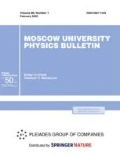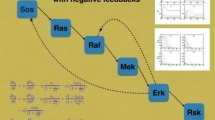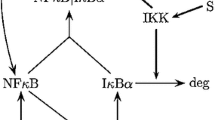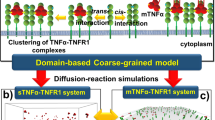Abstract
A mathematical model is suggested for description of translation of the cell activation signals generated by interactions of TLR4 and TNFR2 receptors with ligands. The theoretical background to the construction of the model is offered and the main simulation results are presented. The model takes into account the possibility of self-activation of the cell induced by polymerization of receptors, intersection of signal cascades that may result in depletion of substrates of translating proteins and binding sites on the DNA. The probability of the activation event has a local maximum at the last layer of the reaction graph. The process of cell activation is described by use nonlinear system of singularly perturbed differential equations. All requirements on solution existence have been satisfied and approximate solution has been derived. The boundary conditions type is of importance. Suitably, the probability density of signal transmission from TNFR2 to the cell’s DNA has been specified on the membrane, and flow through the membrane has been set for the probability density of signal transmission from TLR4 to the cell’s DNA. These obstacles necessitate the use of a special algorithm for analyzing nonlinear differential systems with a small parameter for different boundary conditions. The probability densities are qualitatively different themselves, have distinctive structure, emphasizing different ways of cell activation. The density functions of the probability of cell activation make it possible to determine approximately the distribution of the effectiveness of activation inhibitors over the reaction graph layers.
Similar content being viewed by others
References
S. Akira and K. Takeda, Nat. Rev. Immunol. 4, 499 (2004).
P. Christmas, Nat. Educ. 3(9), 85 (2010). https://www.nature.com/scitable/content/structure-and-signaling-of-toll-like-receptors-14455959.
D. Elbert, H. Reinhardt, and M. K. Volkov, Prog. Part. Nucl. Phys. 33, 1 (1994).
B. Manavalan, S. Basith, and S. Choi, Front. Physiol. 2, 41 (2011). https://www.frontiersin.org/articles/10.3389/fphys.2011.00041/full.
A. Chaturvedi, R. Martz, D. Dorward et al., Nat. Immunol. 12, 1119 (2011). doi https://doi.org/10.1038/ni.2116
K. Takeda, T. Kaisho, and S. Akira, Annu. Rev. Immunol. 21, 335 (2003).
T. Kawai and S. Akira, Nat. Immunol. 11, 373 (2010).
S. N. Lester and K. Li, J. Mol. Biol. 426, 1246 (2014).
X. Li, S. Jiang, and R. I. Tapping, Cytokine 49, 1 (2010).
https://www.genome.jp/keggbin/show_pathway?map=hsa04620&show_description=show.
Y. Bulut, E. Faure, L. Thomas, et al., J. Immunol. 167, 987 (2001).
N. D. Titova, Immunopatol., Allergol., Infektol. 3, 32 (2009).
A. Oblak, J. Pohar, and R. Jerala, PLoS ONE 10, e0120583 (2015). https://journals.plos.org/plosone/article?id=10.1371/journal.pone.0120583.
N. Etemadi, J. K. Holien, D. Chau, et al., FEBS J. 280, 5283 (2013). doi https://doi.org/10.1111/febs.12419
D. Brenner, H. Blaser, T. W. Mak, et al., Nat. Rev. Immunol. 15, 362 (2015). doi https://doi.org/10.1038/nri3834
D. Moquin and F. K. Chan, Trends Biochem. Sci. 35, 434 (2010). doi https://doi.org/10.1016/j.tibs.2010.03.001
B. Schrofelbauer and A. Hoffmann, Immunol Rev. 244, 29 (2011). doi https://doi.org/10.1111/j.1600-065X.2011.01060.x
Y. Mukai, T. Nakamura, M. Yoshikawa, et al., Sci. Signaling 3, 83 (2010). https://doi.org/10.1126/scisignal.2000954
L. Ward-Kavanagh, W. W. Lin, S. John, et al., Immunity 44, 1005 (2016). https://doi.org/10.1016/j.immuni.2016.04.019
P. Xie, J. Poovassery, L.L. Stunz, et al., J. Leukocyte Biol. 90, 1149 (2011). https://doi.org/10.1189/jlb.0111044
S. A. Mahmud, L. S. Manlove, H. M. Schmitz, et al., Nat. Immunol. 15, 473 (2014). doi https://doi.org/10.1038/ni.2849
M. P. DeBerge, K. H. Ely, P. F. Wright, et al., J. Leukocyte Biol. 98, 423 (2015).
R. Fischer, O. Maier, M. Siegemund, et al., PLoS One 6, e27621 (2011). doi https://doi.org/10.1371/journal.pone.0027621
P. J. Naude, J. A. den Boer, P. G. Luiten, and U. L. Eisel, FEBS J. 278, 8889 (2011). doi https://doi.org/10.1111/j.1742-4658.2011.08017.x
M. Fotin-Mleczek, F. Henkler, D. Samel, et al., J. Cell Sci. 115, 2757 (2002).
N. Orti-Casan, Y. Wu, P. Naude, et al., Front. Neurosci. 13, 49 (2019). doi https://doi.org/10.3389/fnins.2019.00049
A. Abbasi, K. Forsberg, and F. Bischof, Front. Mol. Neurosci. 8, 21 (2015). https://www.ncbi.nlm.nih.gov/pmc/articles/PMC4466442/.
M. Fallahi-Sichani, M. A. Schaller, D. E. Kirschner, et al., PLoS Comput. Biol. 6, e1000778 (2010).
E. A. Generalov, N. T. Levashova, A. E. Sidorova, P. M. Chumakov, and L. V. Yakovenko, Biophysics 62, 717 (2017).
A. M. Hajjar, D. S. O’Mahony, A. Ozinsky, et al., J. Immunol. 166, 15 (2001).
T. Nishiya and A. L. DeFranco, J. Biol. Chem. 279, 19008 (2004).
V. A. Beloshapko, Math. Methods Appl. Sci. 41, 92645 (2018). doi https://doi.org/10.1002/mma.5235
V. A. Beloshapko, J. Phys.: Conf. Ser. 1334, 012015 (2019).
C. A. Hinojosa, R. A. Suresh Babu, M. M. Rahman, et al., Exp. Gerontol. 54, 58 (2014). https://doi.org/10.1016/j.exger.2014.01.007
A. Dorronsoro, V. Lang, E. Jakobsson, et al., Cell Death Dis. 4, e972 (2013). https://www.nature.com/articles/cddis2013494.
A. Abbasi, K. Forsberg, and F. Bischof, Front. Mol. Neurosci. 8, 21 (2015). https://www.ncbi.nlm.nih.gov/pmc/articles/PMC4466442/
C. A. Hinojosa, R. A. Suresh Babu, M. M. Rahman, et al., Exp. Gerontol. 54, 58 (2014). doi https://doi.org/10.1016/j.exger.2014.01.007
M. Fallahi-Sichani, M. A. Schaller, D. E. Kirschner, et al., PLOS Comput. Biol. 6, e1000778 (2010). https://doi.org/10.1371/journal.pcbi.1000778
B. Riviere, Y. Epshteyn, D. Swigon, and Y. Vodovotz, Math. Biosci. 217, 19 (2009). http://citeseerx.ist.psu.edu/viewdoc/download?doi=10.1.1.711.8094&rep=rep1&type=pdf.
B. Riviere, Y. Epshteyn, D. Swigon, and Y. Vodovotz, Math. Biosci. 217, 19 (2009). http://citeseerx.ist.psu.edu/viewdoc/download?doi=10.1.1.711.8094&rep=rep1&type=pdf.
Funding
This work was supported by the Russian Foundation for Basic Research, project no. 18-31-00402.
Author information
Authors and Affiliations
Corresponding authors
Additional information
Russian Text © The Author(s), 2019, published in Vestnik Moskovskogo Universiteta, Seriya 3: Fizika, Astronomiya, 2019, No. 6, pp. 85–91.
About this article
Cite this article
Beloshapko, V.A., Generalov, E.A. & Yakovenko, L.V. Model of Cell Activation through TLR4 and TNFR2 Receptors. Moscow Univ. Phys. 74, 662–668 (2019). https://doi.org/10.3103/S0027134919060079
Received:
Revised:
Accepted:
Published:
Issue Date:
DOI: https://doi.org/10.3103/S0027134919060079




